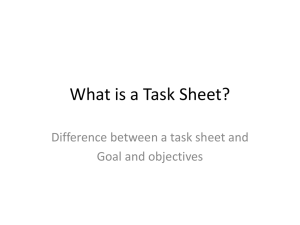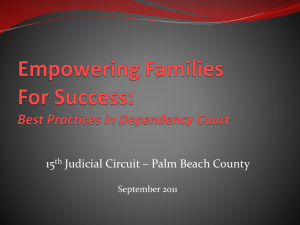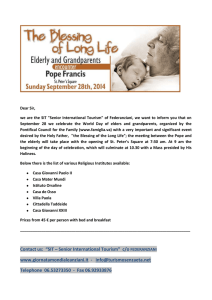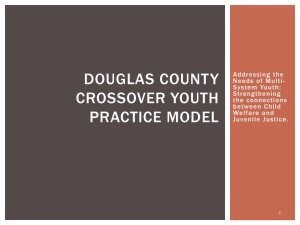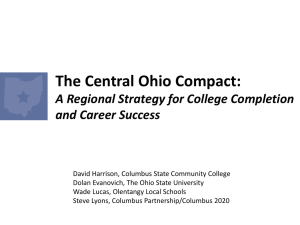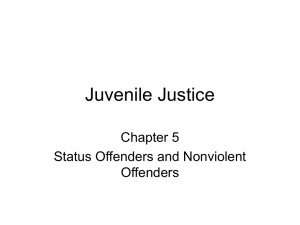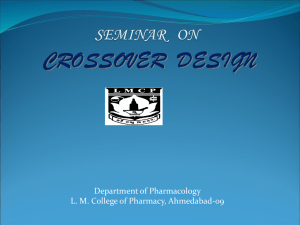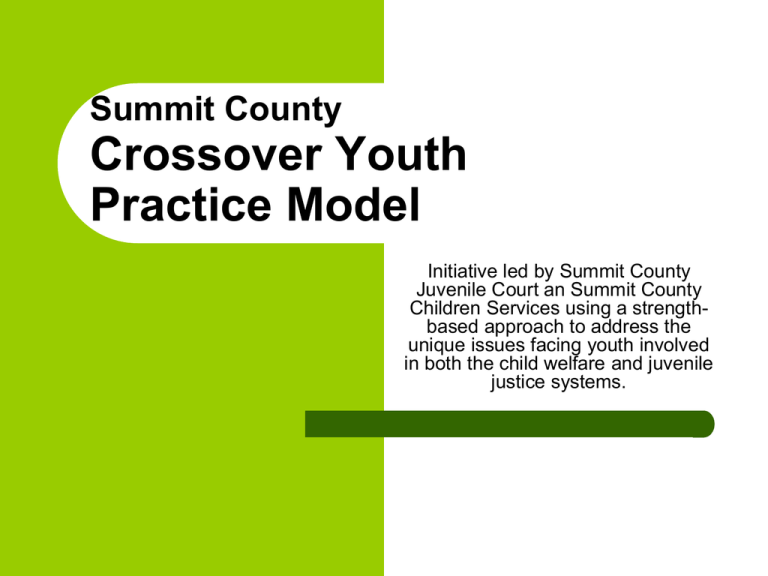
Summit County
Crossover Youth
Practice Model
Initiative led by Summit County
Juvenile Court an Summit County
Children Services using a strengthbased approach to address the
unique issues facing youth involved
in both the child welfare and juvenile
justice systems.
Background:
Research has long documented that youth who have been maltreated
are more likely to engage in delinquent behavior.
Also, if a youth has current or past involvement with the child welfare
system, he/she is more likely than a child not otherwise involved to
recidivate in the juvenile justice system.
However, little was known as to why this was occurring and what could
be done to prevent it.
The Crossover Youth Practice Model (CYPM) helps to answer these
questions and provides a way to address the unique needs of children
known to both systems.
Background:
Casey Family Programs and the Center for Juvenile Justice Reform at
Georgetown University’s Public Policy Institute have been partnering
since 2007 to address the unique issues presented by “crossover
youth.”
The practice model guide can be found at
http://cjjr.georgetown.edu/pm/practicemodel.html
“Crossover Youth” is a general term used in research that refers to
youth that have been a victim of abuse and/or neglect and engaged in
delinquency. Dually-involved youth are known to both the juvenile
justice and child welfare systems in some capacity. In the model the
term crossover youth is used to describe dually-involved youth.
The Crossover Youth Practice Model has been implemented in eight
counties (Carol, Clark, Delaware, Lucas, Montgomery, Ross, Summit
and Trumbull) throughout the State of Ohio.
What do we know about crossover
youth?
There are at least 4 different pathways for a youth to
become involved in both systems:
1.
A youth in the child welfare system who is subsequently charged with
delinquency.
2.
A youth entering the delinquency system with previous (but not current) contact
with the child welfare system.
3.
A youth enters the delinquency system and is currently being maltreated but
has no previous or current contact with the child welfare system.
4.
A youth enters the child welfare system for placement following juvenile justice
confinement because no other option is available.
What do we know about crossover
youth?
They are often in the child
welfare system for long periods
Most are placed out of the
home and often experience
multiple placements.
They are often truant and/or
performing poorly in school.
of time.
They are more likely to be
female as compared to the
general delinquency population.
Minorities, particularly African
Americans, appear to be over
represented.
What is a Practice Model
A conceptual map and organizational ideology that includes definitions
and explanations regarding how staff can partner with families, service
providers, and other stakeholders in the delivery of services to achieve
positive outcomes for youth and their families.
A practice model:
– Describes the practices from case opening to case closure
– Informed by a way of approaching the work (practice principles)
– Includes sequences and techniques
– Reflects evidence based, promising, and best practices in the field
Goals of the CYPM efforts in
Summit County:
Increased communication among agencies.
Increased cooperation, coordination, and integration of services
provided by Summit County Juvenile Court (SCJC), Summit
County Children Services (SCCS) and any additionally involved
agencies.
Increased use and development of joint assessments.
Increased collaboration in case planning and case
management.
Goals of the CYPM efforts in
Summit County cont’d:
Increased family and youth engagement.
Increase improvement at school.
Decreased recidivism in the juvenile justice and child
welfare systems.
Decreased length of stay in detention.
Decrease disproportionate minority contact.
Reduction of out-of-home placement.
Currently Involved with CYPM:
SCJC Judge and Magistrates
Members of SCJC Administration
SCJC Probation Department
SCJC Intake Department
Summit County CASA
Summit County Prosecutor’s Office
Legal Defender Office of Summit
County
SCCS Executive Director
and Directors
SCCS Social Workers
Summit Family and Children
First Council
Akron Police Department
Akron Public Schools
Barberton Police Department
Barberton City Schools
What does a CYPM case look like?
Youth must have an open dependency, neglect, or abuse (DN) case
as well as an open unruly or delinquency (DL) case.
Youth must be living (or placed) in Summit County, at the time they
meet the other criteria.
Youth must be between 10 and 16 years old.
Youth must not currently be in residential placement.
Youth must not be on another specialized docket at the Court.
One Family, One Judge
CYPM participants have their delinquency and dependency,
neglect & abuse court hearings conducted before one Judge (or
Magistrate).
The approach allows judicial officers to become thoroughly
familiar with the needs of the children and families, the efforts
made over time to address those needs and the complexities of
each family’s situation.
Families benefit by having greater familiarity with the judicial
decision maker and courtroom; as well as, from not having to
repeatedly share their stories with a series of changing judicial
officers.
Roles of Involved Individuals:
SCCS caseworker, probation officer or SCJC
intake worker, and CASA will attend all
hearings and CYPM conferences.
A facilitator will guide discussions during
conferences and complete the form to be
presented to the Magistrate.
CYPM Conferences
CYPM conferences will provide the opportunity for representatives
from SCJC, SCCS, CASA/GAL, school personnel, families, and the
youth to share information and plan for success.
CYPM required meetings will include any regularly-scheduled
conferences as well as any SCCS TDMs or SARs.
–
Team Decision Meetings or Semi-Annual Reviews
CYPM Conferences will occur throughout the lifetime of the case:
– Monthly
– SCCS TDMs shall serve as CYPM conferences
– SCCS SARs shall serve as CYPM conferences
– Before each hearing
– As requested
– As scheduled by involved individuals
CYPM Conferences
An agenda will be used during conferences to
promote information sharing.
The team will develop a summary to present to the
Magistrate including:
–
–
–
Progress made by youth and family on existing court orders
New concerns or issues
Assessment explaining recommendations and basis
–
Including an overview of the youths educational status (grades,
attendance) and any education matters requiring attention.
Recommendations of the group indicating participants’ agreement
with individual recommendations.
CASA/GAL
Court Appointed Special Advocate/Guardian ad Litem
–
–
–
Provides the child with a trained community volunteer, appointed by
the Judge, to advocate for what is in the child’s “best interest.”
Serves as an informed, independent, and objective voice for the child.
Provides the Court with information on the child through detailed
testimony and reports.
Each youth involved in the CYPM pilot will receive a CASA or GAL
–
–
CASA/GALs will have the opportunity to participate in a crossover
training to focus on the uniqueness of crossover cases
Court Advocacy Team: 3 staff members who focus on crossover cases
Jen Allen, Pam Bennett, Bethany Lee-Lane
The CASA/GAL Role
The CASA/GAL role in Crossover cases (DN/DL) is very similar to
the role in Dependency cases(DN)
Continue monthly visits
Complete a court report
Advocate for the child’s best interest
Attend meetings for the case such as:
–
TDM, SAR, CYPM TCM
CYPM Team Conference Meetings
–
Be prepared to participate in the meeting and discuss the youth’s
strengths, weaknesses, services, and areas that need improvement
DN and DL flowcharts
Handouts:
–
Compare how the dependency and delinquency
case processes are alike
Example #1 Johnny DV
DL: Delinquency
16 year old Johnny is charged with
Domestic Violence (DV) for fighting with
his mother
Johnny does not get along well with his
mother’s boyfriend, Dan, and often runs
away from the home. He has been
charged with unruly behavior
At the preliminary hearing, Johnny
denies the charge and a Pre-Trial is set
Johnny meets with his attorney and
admits that he did hit his mother
He is ordered to participate in anger
management classes, counseling, and
is ordered to serve 10 days in detention
–
Detention is suspended
DN: Dependency
Johnny has 3 younger siblings (4, 6, 8 y/o)
His mother was out drinking with her
boyfriend Dan. Again.
They return home, Dan was intoxicated &
irate that the 8 year old was not in bed yet.
Dan began to verbally fight with Johnny &
attempt to ground him for not putting all the
kids to bed on time. He shoves Johnny and
Johnny shoves back.
Mother is upset & tries to intervene. Johnny
hits his mother to get her out of the way.
Mother calls the police & reports Johnny for
hitting her. The police couldn’t determine who
initiated the altercation
Police did not arrest mother because of the 3
minor children present, and lack of caregiver.
Example #2: Trisha Truancy
DL (Delinquency)
15 year old Trisha is being
charged with truancy
Trisha has missed the last 2
months
Her mother tells the court
Trisha is just lazy and won’t
listen
She will not pass the 10th
grade, and she is behind
developmentally
Trisha’s mother is charged with
failure to send
DN (Dependency)
Trisha has three siblings (3, 4,
and 8 years old)
Trisha’s mom got a job 2
months ago
It is Trisha’s responsibility to
get the 8 year old ready and off
to school.
Trisha watches the 3 and 4
year old during the day so their
mother won’t loose her job
Example #3 Abby Unruly
DL (Delinquency)
14 year old Abby is charged
with unruly conduct.
She has a history of running
away, AWOL, and truancy
She sneaks out of the house at
night, and sometimes does not
return home after school for
days at a time
DN (Dependency)
14 year old Abby has two siblings (3 and 5
y/o) and a history of going AWOL
Her mother’s live in boyfriend is registered
sex offender with a lengthy criminal history.
DN referral was received indicating mother
was leaving young children in the care of
her boyfriend
He has been touching Abby inappropriately
since she was 12 years old.
Abby has told her mother, but her mother
won’t end the relationship or ask the
boyfriend to leave the home
Abby is terrified of him and what he is
capable of doing.
Ohio Mentoring
In 2013, the Center for Juvenile Justice Reform at Georgetown
University’s Public Policy Institute named Summit County an
Ohio Mentor to the Crossover Youth Practice Model.
“…Expanding the implementation of the model across Ohio
requires strong coaching from not only our faculty at
Georgetown, but also colleagues within Ohio like the leadership
from Summit County who have done a wonderful work in
support of crossover youth.”
-Shay Bilchik
Research Professor at the Georgetown University
Public Policy Institute and Director of it
Center for Juvenile Justice Reform.
Contact Information
Getta Cornici
330-643-2910
gcornici@cpcourt.summitoh.net
Alan Futo
330-643-7828
afuto@cpcourt.summitoh.net
Sarah Noviks
330-643-4549
snoviks@cpcourt.summitoh.net

